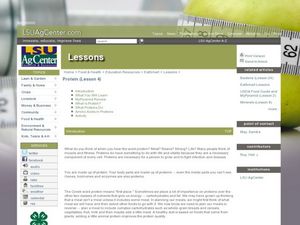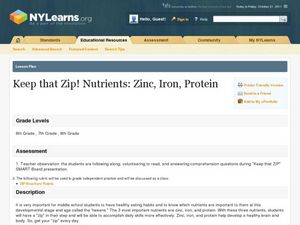Curated OER
Science in Your Shopping Cart
Students research the use of science in food production in the United States. In this science and food lesson, students visit a specific website to learn about the science used in various food products for United States consumption.
Curated OER
Protein
Learners examine protein, what it is and how it functions in the body. In this protein lesson students study the food pyramid, what a protein is and what it does.
Curated OER
Keep that Zip! Nutrients: Zinc, Iron, Protein
Students explain the importance of zinc, iron and protein. In this biology instructional activity, students create a brochure containing information about the three nutrients. They share their brochure in class.
Unite for Literacy
Unite for Literacy: Plants and Food: Bread for Everyone
Learn about the different kinds of breads people eat around the world. Includes audio narration.
US Department of Agriculture
Choose My Plate: All About the Grains Group
There are two types of grains: whole grains and refined grains. Learn about each and find examples. Click on the "Grains Food Gallery" link to see examples, images, and serving sizes of different grains.
Other
The Grain Chain: Where Does Bread Come From?
Help students understand where bread comes from in this series of interactive lessons.
Andre Dollinger
Reshafim: Bread, the Staff of Life
A look at the preparation of flour and the baking of bread in ancient Egyptian kitchens. Bread, the staff of life, was vital to all classes of Egyptians.
University of Illinois
University of Illinois Extension: Food for Thought: Bread, Cereal, Rice, and Pasta
In addition to explaining the nutritional value of foods in the "Bread, cereal, rice, and pasta," group, this website includes information on serving size and book resources on foods in the bread group. Also included is a recipe for...
US Department of Agriculture
Choose My Plate: Why Is It Important to Eat Grains, Especially Whole Grains?
"Why is it important to eat grains, especially whole grains?" This website has the answer. Read about the "health benefits" of eating whole grains and learn about the nutrients found in whole grains.
US Department of Agriculture
Choose My Plate: How to Eat More Whole Grain Food
Find notes at this website that will help you eat whole grains at meals and for snacks. Includes tips for reading food labels and teaching young children how to make healthy food choices.
University of Massachusetts
University of Mass.: Bread, Cereal, Rice, and Pasta
At this website from the University of Massachusetts you can read about the different foods that make up the bread group in the food pyramid. Learn about the nutritional value of bread, cereal, rice, and pasta, and read about the...
CK-12 Foundation
Ck 12: Life Science: Choosing Healthy Foods
[Free Registration/Login may be required to access all resource tools.] Foods such as whole grain breads, fresh fruits, and fish provide nutrients you need for good health. But different foods give you different types of nutrients. You...
Harvard University
Harvard School of Public Health: The Nutrition Source: Fiber
Why is fiber important to our diets? How can we get the fiber we need from the food we eat? In addition to answering the above questions, this website also describes the diseases and disorders we can avoid by eating fiber-rich foods.
Curated OER
Eternal Egypt: Model of Household Activities
This model depicts, in miniature, 12 people carrying out various household activities such as grinding grain, butchering a calf, and baking bread.











